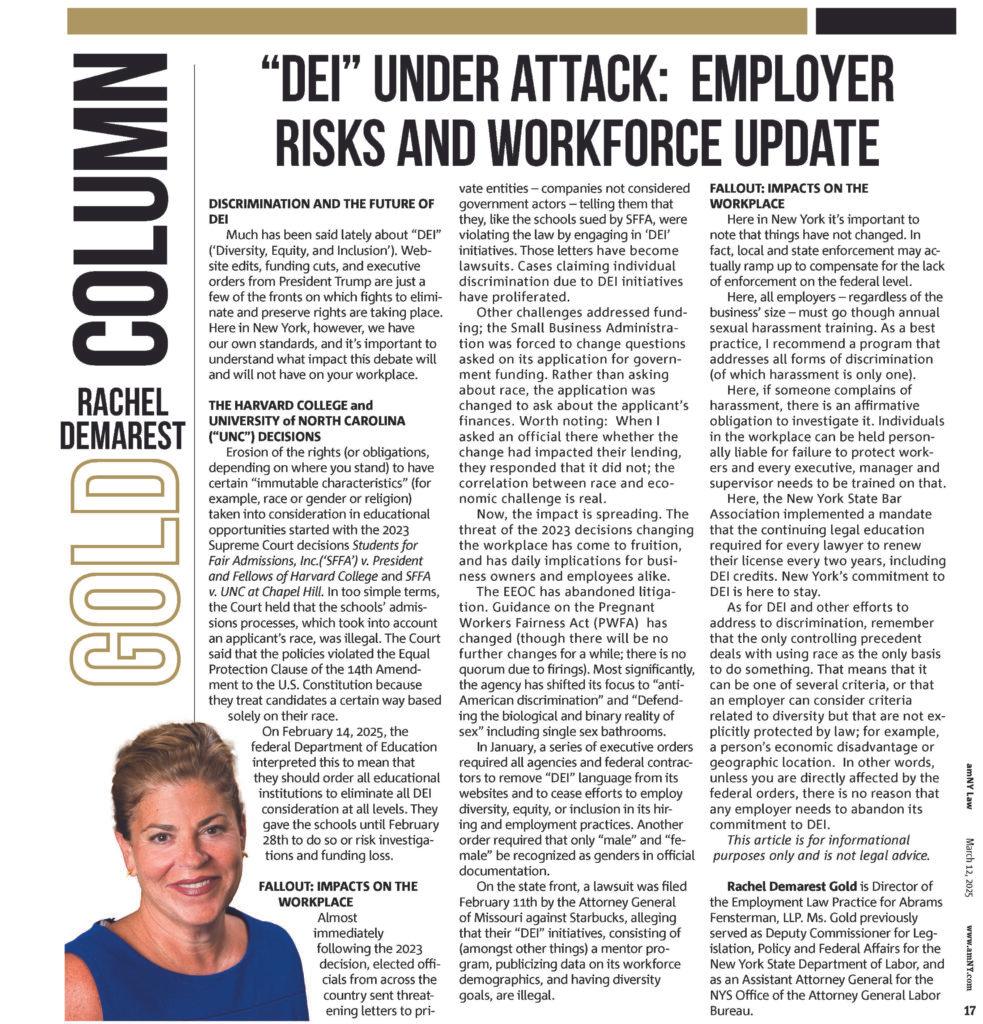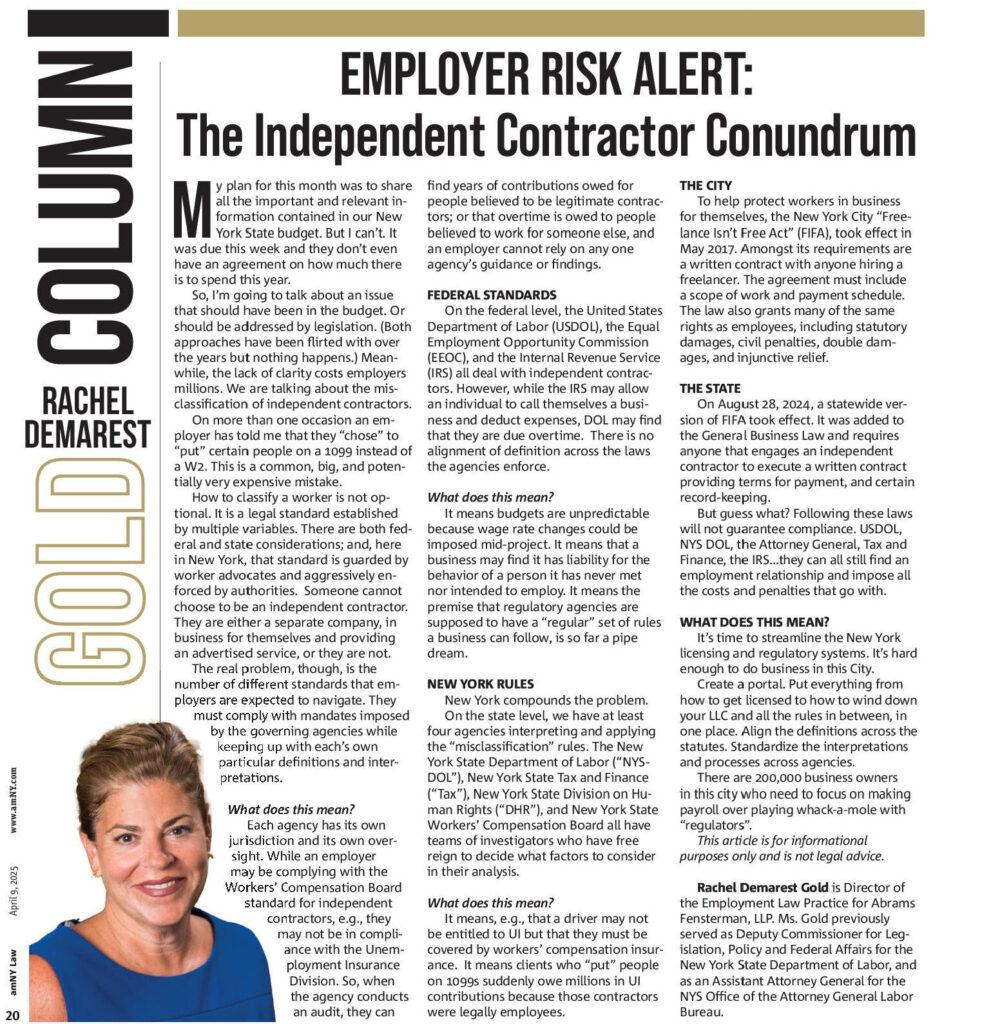This article was published in the April 30, 2025 edition of amNY Law.
An employer’s obligations regarding employee harassment complaints are extensive and specific. Not knowing them gets expensive fast.
The Policy
New York law requires all employers to establish and distribute certain policies, including one on sexual harassment. The policy must include examples of illegal conduct; the federal, state and local laws protecting workers from the behavior; a timely and confidential procedure for investigating complaints; information on workers’ rights and how to exercise them. The law also mandates that the policy include an anti-retaliation provision, and statements that: harassment is misconduct, and supervisors or managers who allow such behavior will be disciplined.
The Complaint Form
The required policy must also include a complaint form. The most important thing to know, though, is that there should be at least two people listed to whom employees can send their complaint. A victim should never have to complain to their assailant.
The Training
Since 2018, sexual harassment training is required for every worker every year. My personal opinion is that it was irresponsible for the State Legislature to require the mandatory sexual harassment training and then ignore it every year since. Sexual harassment is a form of gender discrimination – a subset of discrimination which applies to all protected categories including race, religion, and national origin (among many others). To make the training just about gender is a mistake. It ignores many important and related issues, and is a missed opportunity. Training for my clients always addresses all forms of discrimination and that is a best practice to include across all size workforces and industries.
As for the content requirements, however, much like the policy and form discussed above, the training mandate is very specific. Training must be interactive, include definitions as established by the New York State Department of Labor and the Division of Human Rights, include examples, discuss the statutes and remedies available to employees, and address supervisor responsibilities. It is important to note: Supervisors and levels of management have an obligation to get involved if they witness harassing behavior. There is personal liability if they fail. Some companies should consider additional, separate training.
The Investigation
As a former assistant district attorney and assistant attorney general, I use the same tools and techniques employed to build a criminal case as when looking into complaints of worker misconduct. Criminal behavior should be reported to law enforcement immediately, but investigations into allegations of workplace discrimination should be handled no less carefully.
That starts with a list of every person who might have information. Not just witnesses to what was reported, but people who saw the involved before and after, and those who may have witnessed similar situations involving the same actors. Every person – on each side of the dispute – must be interviewed. Those statements should be in writing.
Every piece of “documentary” evidence should be identified and preserved. Beyond the traditional idea of “documents,” this includes everything the worker may have created or communicated – videos, text messages, emails, voicemails, social media screenshots. Don’t look for limits; gather all of it. The focus is not the permission of the employer, it is the possible existence of evidence. Where it was created, when it was deleted, and who had access along the way is relevant. Seeing how people interact before or after they return to a room without a camera can be equally as valuable as footage of an incident itself.
Throughout the process remember the law says that the investigation must ensure due process. That means speak to and notify the accused. Give them an opportunity to respond. And document the steps taken to protect their rights.
Once all the information has been evaluated, document findings and next steps taken – whether disciplinary or corrective action. Most importantly however, follow your internal policy. Referring to a company’s own policy and acting on being the best evidence against it that the company engaged in discriminatory practices.
Once decisions are made and reports written up, tell the complainant and the accused as much as you can without violating other employees’ privacy. Most significantly, they both have the right to know the results of the investigation and action taken as a result, if any.
Final Thoughts on Best Practices
Don’t let it linger: New York law requires that investigations be handled timely, but even if it did not, memories fade and resentments simmer. Address these situations right away.
Follow through: Watch how people behave after the investigation. A person who has been gaslighted or otherwise disciplined for misbehavior isn’t going to become nicer when they return. Additional and remedial training is generally required.
Invest in prevention: No complaint is just about one situation. It’s the culture, the perception, and ultimate liability of the entire business.
Rachel Demarest Gold is Director of the Employment Law Practice for Abrams Fensterman, LLP. Ms. Gold previously served as Deputy Commissioner for Legislation, Policy and Federal Affairs for the New York State Department of Labor and as Assistant Attorney General in the Labor Bureau of the Attorney General for New York.





